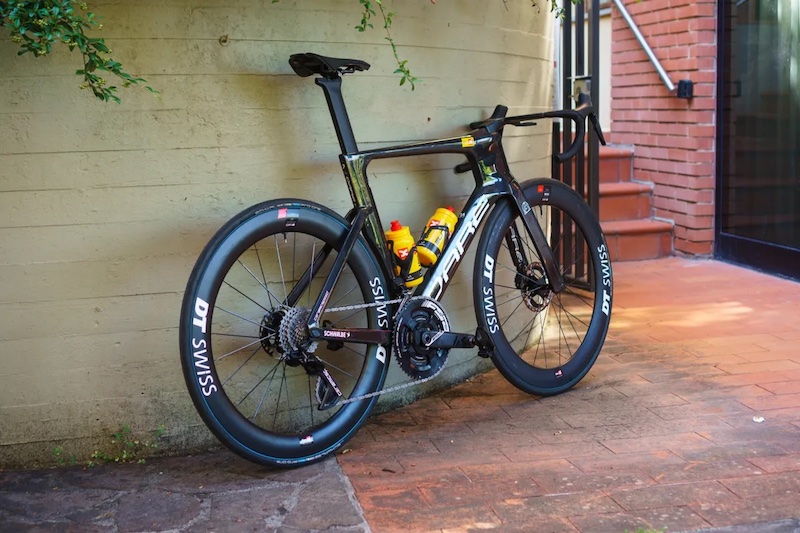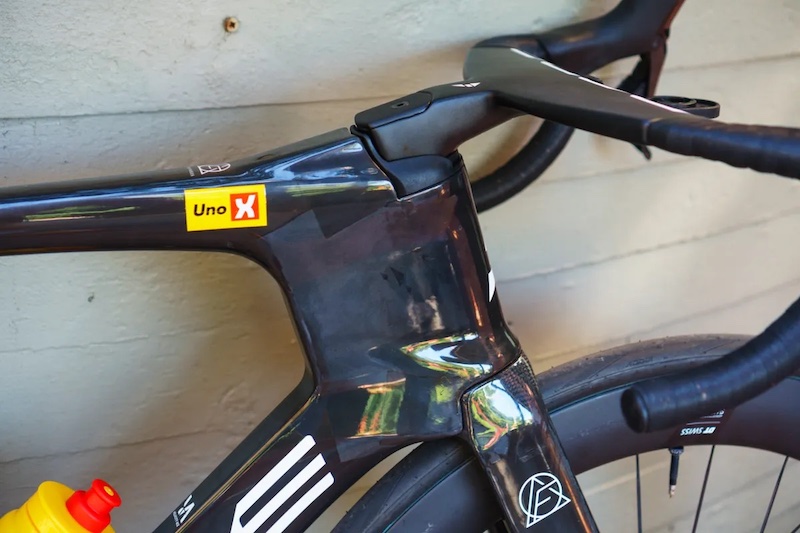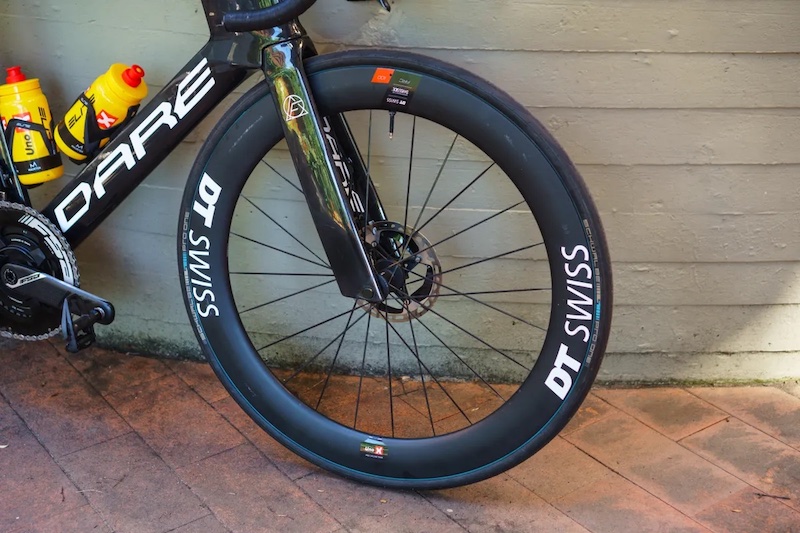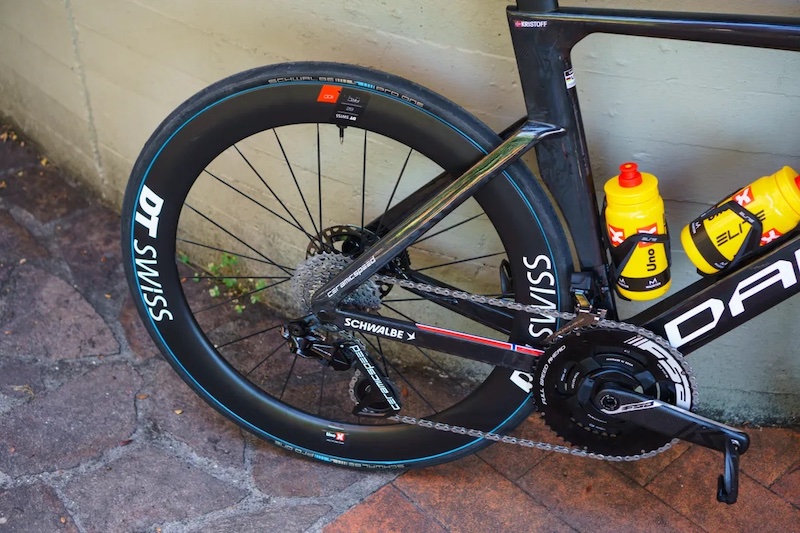Categorías de Producto
nuevos productos
El equipo Uno-X monta una bicicleta de carretera aerodinámica radical e inédita en el Tour de Francia 2024.
Producida por la marca taiwanesa (y patrocinadora del equipo Uno-X) Dare, la bicicleta se opone a la tendencia predominante de bicicletas todoterreno y, en cambio, adopta un enfoque hiperaerodinámico con poca consideración aparente por el peso.
Antes del inicio de la carrera en Florencia, Italia, pudimos ver de cerca la nueva bicicleta en el hotel del equipo Uno-X.
¿Podría ser esta la bicicleta que ayude al equipo Uno-X a conseguir su primera victoria en la carrera más importante de este deporte?

El regreso de la bicicleta aero
En los últimos años, hemos visto a varias marcas destacadas abandonar las bicicletas de carretera aerodinámicas en favor de modelos que equilibran el rendimiento aerodinámico con el bajo peso.

Specialized, por ejemplo, dejó de lado su S-Works Venge cuando lanzó el S-Works Tarmac SL7 en 2020, mientras que la Madone SLR de octava generación recientemente anunciada por Trek marcó el final de su Émonda.
Del mismo modo, el lanzamiento de un ligero Giant Propel Advanced SL en 2022 ha visto al icónico TCR de la marca relegado a un uso limitado en el WorldTour.
Dare parece estar adoptando el enfoque opuesto, con un diseño más parecido a otras bicicletas de carretera aerodinámicas como la Cervélo S5, Ribble Ultra SLR y Cannondale SystemSix Hi-Mod.
Por lo que sabemos, la nueva bicicleta de carretera aerodinámica de Dare parece llamarse 'Velocity Ace', ya que está impreso en el tubo diagonal.
Lo más probable es que sea una actualización de la bicicleta aerodinámica existente de la marca, la VSRu. Sin embargo, la nueva bicicleta duplica las optimizaciones aerodinámicas, con formas de tubos aerodinámicos más profundos por todas partes y una construcción centrada completamente en la velocidad.
Tubos profundos en todos los sentidos
El tubo de dirección es una de las partes más llamativas del Velocity Ace.

Utiliza un perfil aerodinámico profundo y truncado y se eleva desde el tubo superior para encontrarse con la parte trasera del nuevo manillar integrado de la bicicleta (más sobre esto más adelante).
En el extremo inferior, el tubo de dirección está esculpido para controlar el flujo de aire que sale de la corona de la horquilla.
Visto de frente, el tubo de dirección tiene forma de reloj de arena, estrechándose entre los cojinetes de dirección superior e inferior para reducir aún más la resistencia.

Mientras que la horquilla de la VSRu se estrechaba ligeramente hacia la parte inferior, las patas estrechas de la nueva horquilla se mantienen profundas hasta el final.
Mientras que el tubo diagonal del VSRu tenía un pequeño corte para la rueda delantera, el Velocity Ace tiene un tubo diagonal recto con un perfil aerodinámico truncado más profundo y ancho.

A diferencia de la nueva Trek Madone SLR, la Velocity Ace utiliza portabidones estándar no integrados con botellas de agua redondas para ciclismo.
Sin embargo, es posible que el tubo diagonal rediseñado proporcione una mayor gestión del flujo de aire alrededor de esta área que antes.
En la parte trasera de la bicicleta, los perfiles aerodinámicos del tubo del sillín, los tirantes y la tija del sillín también se han profundizado significativamente.

Queda por ver si esto tiene algún impacto en el cumplimiento. Sin embargo, dejando a un lado los tirantes, no parece que Dare haya hecho muchas concesiones a la comodidad.
Like some time trial bikes, the seatpost appears to have multiple saddle clamp locations, enabling a rider to adjust the effective seat tube angle – an important consideration for fit purposes.
One of the deepest handlebars we’ve seen

Beyond the head tube, the bike’s new aero handlebar is also remarkable, thanks to its use of an exceptionally deep and thin aerofoil profile on the tops.
Expectedly, the handlebar uses an integrated design, with the hydraulic brake hoses fully concealed within the bar and running into the frame unseen.The top tube rises to meet the rear of the stem, while the headset top cap has been cleverly profiled to smooth out the junction between the two.
Overall, Dare’s new bar appears to take the opposite approach to Ribble’s ground-breaking Ultra handlebar (which features on the Ultra SLR). The Ribble bar uses a similarly deep aerofoil profile, but is much more bulbous, as it’s designed to manipulate the airflow hitting the rider behind it.
Notably, Trek says the updated handlebar on its recently launched, eighth-generation Madone SLR does something similar (albeit on a smaller scale).
The Dare handlebar, in contrast, looks to be designed simply to reduce its impact on the airflow as much as possible.
As with rear-end comfort, there doesn’t seem to have been much consideration for a rider being able to hold the tops of the handlebar. As with the rest of the bike, it looks to be all about maximising aerodynamic efficiency.
On this bike, which belongs to four-time Tour de France stage winner, Alexander Kristof, the cockpit combines a 120mm-long stem with a 380mm-wide handlebar (measured centre to centre at the brake hoods).
The frame also has a logo noting the headset contains CeramicSpeed's SLT (Solid Lubrication Technology) bearings – which are claimed to provide exceptionally long lifespans, reducing the frequency with which the front end requires servicing.
A speed-focused build with personal upgrades
The rest of the build sees an uncompromising focus on speed.
Like last year, Kristof’s wheelset of choice is the DT Swiss ARC 1100 Dicut DB, with 62mm-deep rims.
These are wrapped with Schwalbe Pro One TLE tyres, in a 700 x 28c size that measures up at 27.9mm-wide on the DT Swiss rims.
As with last year, the tyres have conspicuous blue accents that don’t come on the versions of the Pro One TLE available in shops.
Having spotted these last year, we asked Schwalbe if this was a new, updated version of the German brand’s highly-rated tubeless tyre. Unfortunately, the brand declined to shed any light on the subject.
According to our well-informed YouTube audience, though, these could be special-edition, race day-only versions of the tyre – something faster, lighter but potentially less durable than the standard tyres, for example.
Schwalbe has apparently created similarly-branded tyres for its sponsored mountain bike athletes previously, so that could be what’s going on here.
As for the drivetrain, Kristof and his Uno-X team are still running Shimano’s flagship Dura-Ace Di2 R9200 groupset.
This year, though, the team has switched from using Shimano’s Dura-Ace FC-R9200-P power meter crankset to FSA’s Powerbox Team.
This consists of an FSA power meter spider (which we believe is made by Power2Max) paired with the brand's carbon cranks and aluminium chainrings.
When we saw Kristof’s bike, a couple of days out from the race start, it was equipped with some huge 56/40t chainrings.
Even though these were paired with a wide-ranging 11-34t cassette out back, we wonder whether Kristof might have swapped to something smaller for the race’s mountainous opening stage.
Perhaps due to a change in team sponsor, Kristof has switched saddles from the Pro Stealth Curved Team he used at last year’s Tour to a Prologo Scratch M5 with carbon rails.
Finishing things off, Kristof’s bike was also decked out with CeramicSpeed’s latest OSPW (Oversized Pulley Wheel System) RS Alpha and a waxed chain.
The 'Alpha Disc' solid pulley wheels are claimed to prevent dirt or debris entering the system and contaminating the bearings.
A new bike that’s heavier than the old one
It’s rare to see a new road bike released that’s significantly heavier than the outgoing version, but that’s exactly what we have here.
According to Dare, the VSRu had a claimed frame weight of 1,190g in a size small (although Kristof rides a 56cm frame). While we don’t yet have a claimed weight for Velocity Ace frame, we think its deeper tubes and aggressive aerodynamic optimisations have likely added weight.
That appears to be confirmed by the overall weight of Kristof’s Dare Velocity Ace, too, which came in at spot-on 8kg, according to our scales.
That’s 255g more than the 7.745kg weight we took for his Dare VSRu at last year’s Tour.
As things stand, that’s all we know about Dare’s radical new aero road bike.
Given a number of Uno-X riders are using the bike at this year’s Tour, it appears the bike is production ready and could launch imminently.
Frameset: Dare Velocity Ace (size 56cm) our Tour recycling have similar aero road carbon bike frames hotsale such as TDC-RD49,also developed new aero super weight road frame design TDC-RD55. these designs are more advanced and high performance in our customers. Welcome to send your inquiry to brand your new markets.
Groupset: Shimano Dura-Ace Di2 R9200 with FSA PowerBox Team power meter (56/40t chainrings, 11-34t cassette), FSA carbon cranks, CeramicSpeed OSPW RS Alpha and UFO waxed chain
Wheelset: DT Swiss ARC 1100 Dicut 62 DB
Tyres: Schwalbe Pro One TLE 29c (measured width 27.9mm)
Bar/stem: Dare, 38cm handlebar width, 12cm stem length
Seatpost: Dare
Saddle: Prologo Scratch M5 Nack
Bottle cages: Elite Vico Carbon
Pedals: Shimano Dura-Ace
NOTE: MAIN ARTICLE FROM WEBSITE